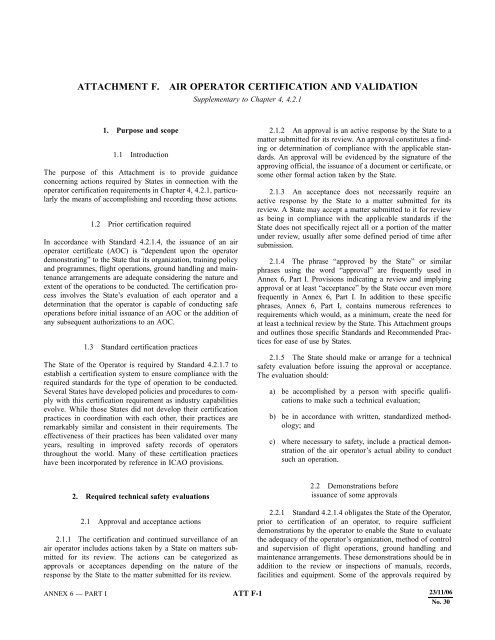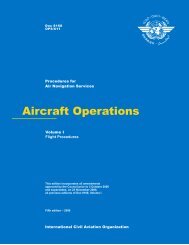Operation of Aircraft
Annex 6, Part I
Annex 6, Part I
- No tags were found...
Create successful ePaper yourself
Turn your PDF publications into a flip-book with our unique Google optimized e-Paper software.
ATTACHMENT F.<br />
AIR OPERATOR CERTIFICATION AND VALIDATION<br />
Supplementary to Chapter 4, 4.2.1<br />
1. Purpose and scope<br />
1.1 Introduction<br />
The purpose <strong>of</strong> this Attachment is to provide guidance<br />
concerning actions required by States in connection with the<br />
operator certification requirements in Chapter 4, 4.2.1, particularly<br />
the means <strong>of</strong> accomplishing and recording those actions.<br />
1.2 Prior certification required<br />
In accordance with Standard 4.2.1.4, the issuance <strong>of</strong> an air<br />
operator certificate (AOC) is “dependent upon the operator<br />
demonstrating” to the State that its organization, training policy<br />
and programmes, flight operations, ground handling and maintenance<br />
arrangements are adequate considering the nature and<br />
extent <strong>of</strong> the operations to be conducted. The certification process<br />
involves the State’s evaluation <strong>of</strong> each operator and a<br />
determination that the operator is capable <strong>of</strong> conducting safe<br />
operations before initial issuance <strong>of</strong> an AOC or the addition <strong>of</strong><br />
any subsequent authorizations to an AOC.<br />
1.3 Standard certification practices<br />
The State <strong>of</strong> the Operator is required by Standard 4.2.1.7 to<br />
establish a certification system to ensure compliance with the<br />
required standards for the type <strong>of</strong> operation to be conducted.<br />
Several States have developed policies and procedures to comply<br />
with this certification requirement as industry capabilities<br />
evolve. While those States did not develop their certification<br />
practices in coordination with each other, their practices are<br />
remarkably similar and consistent in their requirements. The<br />
effectiveness <strong>of</strong> their practices has been validated over many<br />
years, resulting in improved safety records <strong>of</strong> operators<br />
throughout the world. Many <strong>of</strong> these certification practices<br />
have been incorporated by reference in ICAO provisions.<br />
2.1.2 An approval is an active response by the State to a<br />
matter submitted for its review. An approval constitutes a finding<br />
or determination <strong>of</strong> compliance with the applicable standards.<br />
An approval will be evidenced by the signature <strong>of</strong> the<br />
approving <strong>of</strong>ficial, the issuance <strong>of</strong> a document or certificate, or<br />
some other formal action taken by the State.<br />
2.1.3 An acceptance does not necessarily require an<br />
active response by the State to a matter submitted for its<br />
review. A State may accept a matter submitted to it for review<br />
as being in compliance with the applicable standards if the<br />
State does not specifically reject all or a portion <strong>of</strong> the matter<br />
under review, usually after some defined period <strong>of</strong> time after<br />
submission.<br />
2.1.4 The phrase “approved by the State” or similar<br />
phrases using the word “approval” are frequently used in<br />
Annex 6, Part I. Provisions indicating a review and implying<br />
approval or at least “acceptance” by the State occur even more<br />
frequently in Annex 6, Part I. In addition to these specific<br />
phrases, Annex 6, Part I, contains numerous references to<br />
requirements which would, as a minimum, create the need for<br />
at least a technical review by the State. This Attachment groups<br />
and outlines those specific Standards and Recommended Practices<br />
for ease <strong>of</strong> use by States.<br />
2.1.5 The State should make or arrange for a technical<br />
safety evaluation before issuing the approval or acceptance.<br />
The evaluation should:<br />
a) be accomplished by a person with specific qualifications<br />
to make such a technical evaluation;<br />
b) be in accordance with written, standardized methodology;<br />
and<br />
c) where necessary to safety, include a practical demonstration<br />
<strong>of</strong> the air operator’s actual ability to conduct<br />
such an operation.<br />
2. Required technical safety evaluations<br />
2.1 Approval and acceptance actions<br />
2.1.1 The certification and continued surveillance <strong>of</strong> an<br />
air operator includes actions taken by a State on matters submitted<br />
for its review. The actions can be categorized as<br />
approvals or acceptances depending on the nature <strong>of</strong> the<br />
response by the State to the matter submitted for its review.<br />
2.2 Demonstrations before<br />
issuance <strong>of</strong> some approvals<br />
2.2.1 Standard 4.2.1.4 obligates the State <strong>of</strong> the Operator,<br />
prior to certification <strong>of</strong> an operator, to require sufficient<br />
demonstrations by the operator to enable the State to evaluate<br />
the adequacy <strong>of</strong> the operator’s organization, method <strong>of</strong> control<br />
and supervision <strong>of</strong> flight operations, ground handling and<br />
maintenance arrangements. These demonstrations should be in<br />
addition to the review or inspections <strong>of</strong> manuals, records,<br />
facilities and equipment. Some <strong>of</strong> the approvals required by<br />
ANNEX 6 — PART I ATT F-1 1/11/01 23/11/06<br />
No. 30












